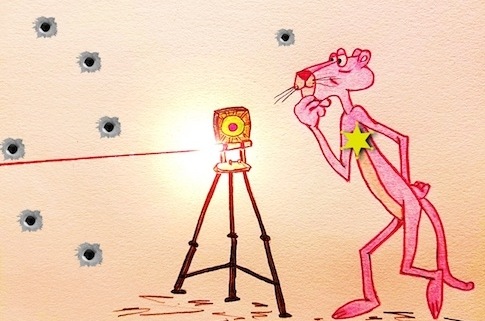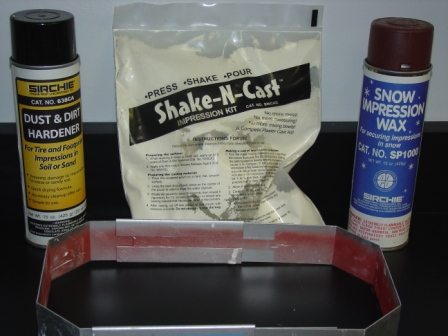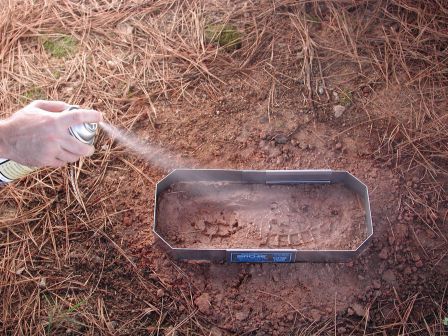There’s nothing more boring than to read a book where the author lists a bunch of facts without any means whatsoever for us, the readers, to visualize how the crime is solved. You know the ones of which I speak …
The cop, Detective Sergeant Snoozer, found a plastic garbage bag filled with dirty clothing. He said to his partner, “I wonder if those reddish, brown stains could be blood, and I wonder where they got the bag? It looks familiar. Oh, well, we should look for real clues, I guess, such as fingerprints and other junk. And toss that piece of pipe over into the woods before someone trips over it.”
For goodness sake, all it would take to add a bit of zing to this incredibly mind-numbing scene is to insert a few cool facts (not an information dump, though!).
Show us how the detective uses science and personal experience to match the spots where the garbage bag was torn away from the roll to the roll found in the crook’s hideout. Show us how they determined that the stains were indeed blood, and that the pipe could be tied to a suspect who’d not left behind any fingerprints.
Show me, show me, show me this “junk.”
Show us a few details. Details that will surprise your readers. Make them interested in the scene. Impress them with the special knowledge and skills of your protagonists. Or, for a fun twist, show the villain attempting to disguise or erase the evidence. You want your readers to become invested in your characters, right?
To help add a touch of pizzazz to your story, here are 6 Ways to Transform a Boring Crime Scene into Fascinating Factual Fiction.
Tear points and striations
1. It’s possible to match tear points and striations of plastic garbage bags to the points where they were torn/separated from the roll. Thus, enabling investigators to prove a bag containing body parts was removed from the roll found beneath the kitchen sink inside the suspect’s apartment.
Laser trajectory
2. Examining defects and holes in various materials caused by projectiles from firearms can provide information about the round fired, the position of the shooter, the firearm from which it was fired, the direction of travel, and sometimes the order of shots fired. The use of lasers and/or stringing helps determine bullet trajectory. (See Detective P. Panther above)
Electrostatic dust print lifting
3. As we walk, our shoes transfer dust and other other particulate matter to the various surfaces that have walked upon, leaving behind latent/unseen impressions of our footwear. Electrostatic dust print lifting provides the ability to successfully collect those impressions.
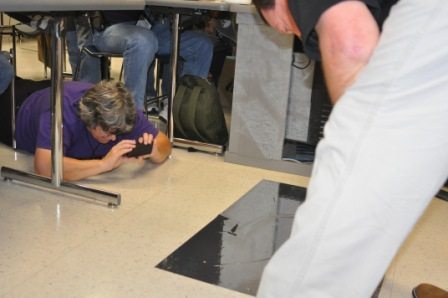
Author Donna Andrews photographing electrostatic dust print. ~ Writers’ Police Academy
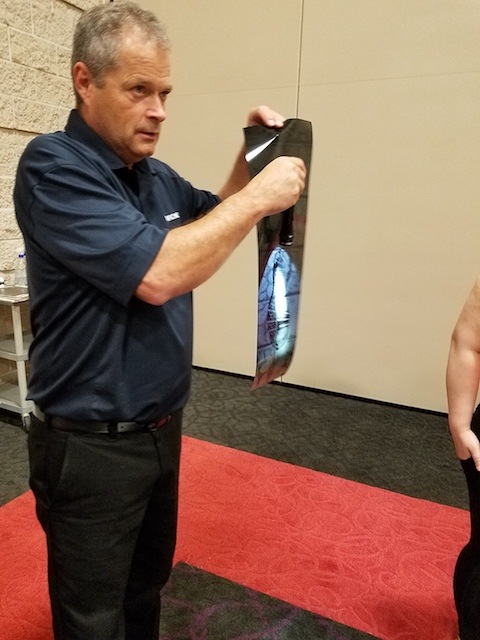
Jim Reynolds of Sirchie demonstrates electrostatic dust print lifting. 2018 Writers’ Police Academy
Sirchie’s Shake-N-Cast Kit
4. Dental stone casting material is used for the collection and preservation of footwear and tire track impressions. Since dental stone casting material emits heat during the process of hardening, a fixative must be used when casting in snow and/or icy conditions.
Investigators often keep an impression casting kit in the trunk of their police car. I did. In fact, mine was a kit comprised of products from our good friends at Sirchie.
~ Sirchie image.
Impression casting kits contain a casting material that’s similar in composition to the material dentists use when making impression molds for dentures. The kits also contain dust, dirt, and snow hardener.
Sirchie’s Shake-N-Cast (center in photo) contains a pre-measured water pouch and the aforementioned dental stone. Apply pressure to break the water pouch and shake to mix the two ingredients. No messy containers and no casting material on a detectives shiny shoes. There’s enough material in a kit to cast an adult-size shoe up to 15″ long.
Metal casting frames are adjustable to fit all shoe sizes and most tire treads.
The spray in the can on the left in the above photo—Dust and Dirt Hardner—is used to strengthen impression evidence (tire tracks, footwear impressions, etc.) found in loose or sandy soil.
~ Sirchie image.
A squirt or two of Sirchie’s Snow Impression Wax provides an insulating medium between the heat-generating casting material and the surrounding snow. Once the spray contacts the snow it locks in the impression details while the casting material hardens.
Snow impression wax prevents snow from melting during the casting procedure. ~ Sirchie image.
The well-mixed combination of water and the dental casting material is poured directly from the bag into the pre-treated impression.
The result, after hardening, is a cast of suspect’s footprint.
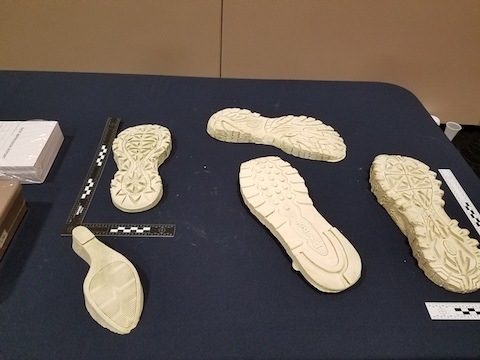
The cast is used to identify a suspect’s shoes by size and unique characteristics, like cuts and indentations. The cast also becomes part of the evidence that’s used in court. Image – 2018 Writers’ Police Academy, Sirchie demonstration
Trace Metal Detection (TMDT)
5. Suppose the murder victim in your twisted macabre tale was bludgeoned to death with a section of metal pipe used by a psycho killer only you could create from details embedded in that wacky and weird place deep inside your imagination. But there were no telltale usable fingerprints left behind on the murder weapon. How could the hero of your story solve the crime without prints to tie the killer to the pipe?
Aw, heck, this is as easy as solving the convenience store robbery where the crook left his photo ID on the counter.
All your hero needs is a bit of trace metal detection solution and a UV light. Simply apply the solution to the suspect’s hands, or clothing, and then hold the light over the area where they applied the solution. If the person contacted the metal murder weapon/device, the proof appears like magic.
Here’s how it works.
When holding or contacting a metal object, metal ions transfer from the object to our skin (or clothing). The ions then react with the Trace Metal Detection (TMDT) solution applied by the investigator. Immediately upon contact, the ions begin to fluoresce under ultraviolet (UV) light. To make this process even more cool, the color ranges of the fluorescence indicates the precise type of metal contacted, such as aluminum (shows as a bright whitish color), copper (deep blue), and lead (a shade between the former two colors).
To add to the supreme coolness of this stuff, even the patterns observed on the skin can indicate the general shape(s) of the metal object contacted by the suspect. This process is often used in corroboration of suicide when firearms are used. It proves the victim held the weapon used to cause the death.
Phenolphthalein
6. To determine if a suspected stain discovered at a crime scene is blood, or not, a presumptive test should be performed. Phenolphthalein is such a test and it reacts with the heme molecule present in blood. It is not species exact, meaning the test does not prove whether or not the blood is that of a human. Should the result be positive, samples should be collected and delivered to a testing lab.
But a positive result does provide investigators with the knowledge that blood is indeed present at the crime scene. It doesn’t require rocket science at that point to connect the dots—place is in disarray, potential victim is missing, neighbor heard gunshots, blood of some type is found on the floors, wall, ceiling, and make up a series of bloody drag marks leading to front door, down the steps, and to the driveway. Hmm …
Here’s the test kit.
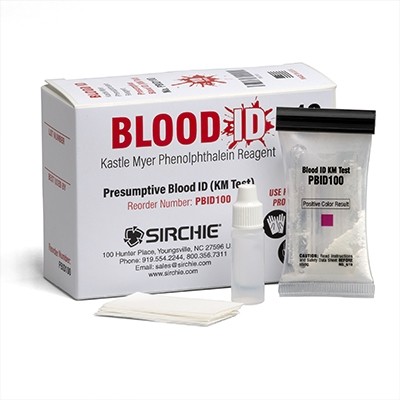
Above image – Sirchie
The procedure.

